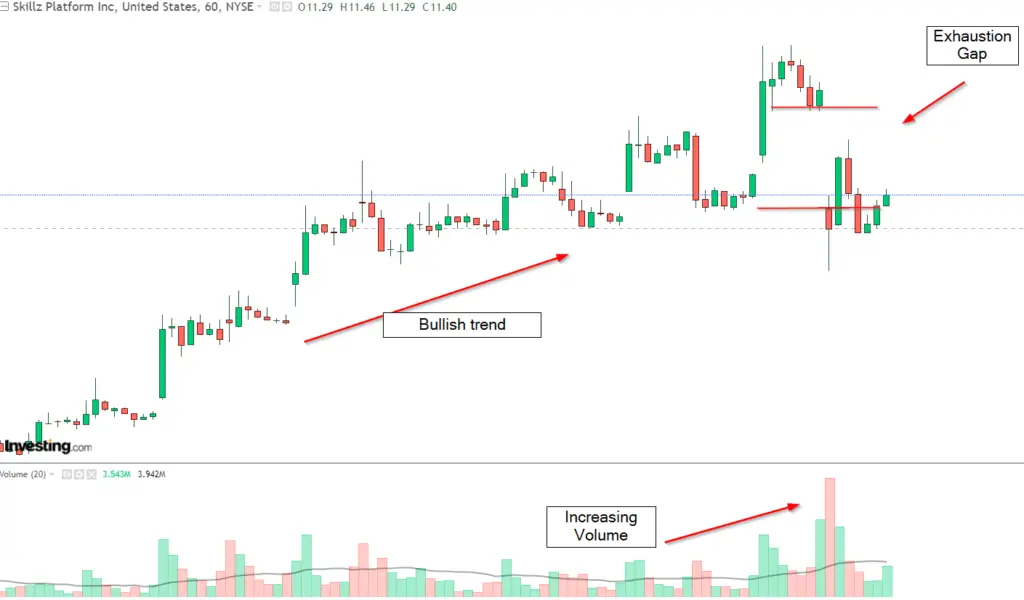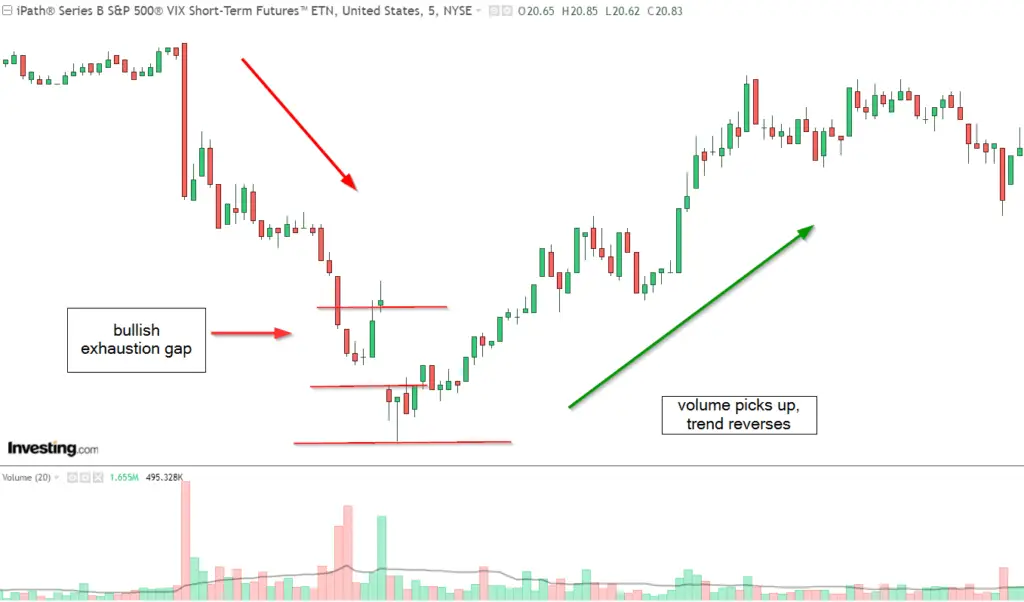The exhaustion gap is a unique type of stock gap to understand in order to time your exits and avoid taking trades. It’s a price pattern that is important to understand so you can avoid taking trades.
Summary
- An exhaustion gap marks the potential change from an uptrend to a downtrend in price, or visa versa
- It’s used as a key indicator for traders to exit a trade
- There are two types of exhaustion gaps, bullish and bearish
What is the Exhaustion Gap?
An exhaustion gap is a price gap that occurs after a trend begins to break down following a rapid rise in a stock’s price. This gap signals a significant change in the demand for a stock and is followed by a sharp decline in the price of a stock.
An exhaustion gap is a strong indication of the end of an uptrend and the start of a downtrend. It’s important to recognize price levels at which exhaustion gaps occur because they can serve as a good point of exit for trades.
Understanding Exhaustion Gaps in Trading
The exhaustion gap is considered by many technical traders as a key indicator that a trend is over and it’s typically used as a sign of trend reversal. It usually occurs after a volatile price move to the upside has taken place and buyers have pushed the price of a stock as high as it can go before they decide to take profits.
After this parabolic peak in price, sellers aggressively step in and begin to drive the price of the stock down. This indicates that buyers are no longer interested in purchasing the stock at the inflated price during that period of time. Once the exhaustion gap starts, the trading volume will increase significantly.
Why Do Exhaustion Gaps Occur?
Exhaustion gaps occur due to a shift in perspective about the current price of a stock from retail and institutional traders. Some of the reasons that exhaustion gaps occur are technical, fundamental, and even psychological. There’s a significant shift from buyers to sellers which ends up changing the trend of the stock.
Exhaustion gaps can cause either a temporary pullback in price or a complete shift in the trend of the stock. If the exhaustion gap was triggered due to a significant news event, chances are high that the stock will start a new trend. When the momentum of a stock begins to slow down, there’s a high likelihood that an exhaustion gap will occur.
Properties of Exhaustion Gaps
- A sustained period of an uptrend in the price of the stock (weeks or months)
- The stock is trading above its average daily volume
- An aggressive move to the upside or downside
- The price drop will break the most recent trend
Different Types of Exhaustion Gaps
There are two different types of exhaustion gap patterns depending on the current trend of the stock. Stocks can be in an uptrend and they can also be in a downtrend. As such there are two different types of exhaustion gaps, bullish and bearish.
Important: It’s worth nothing that exhaustion gaps tend to occur after breakaway gaps have taken place and formed a strong uptrend or downtrend in price.
Bearish Exhaustion Gaps ( Example 1 )
A bearish exhaustion gap starts to develop at the end of a strong up-trend. A bearish gap signals that buyers are losing their momentum and that sellers are now in control of the stock price.

This usually signals an opportunity for buyers to exit the trade or for shorts to enter.
Bullish Exhaustion Gaps ( Example 2 )
A bullish exhaustion gap begins at the end of a strong bearish trend. A bullish gap signals that sellers have been exhausted and that an uptrend is getting ready to reverse.

This presents an opportunity for buyers to enter into a long position or for shorts to cover their positions. The buying volume has to pick up during a bullish exhaustion gap as it will help reverse the trend.
Conclusion
Being able to spot and make sense of exhaustion gaps can help you better understand trends and trend reversals. When price breaks an old trend, it can present an opportunity for a more advantageous entry into a position. In addition to this, exhaustion gaps will vary across different asset classes. Certain asset classes can have much more volatile gaps and trends.